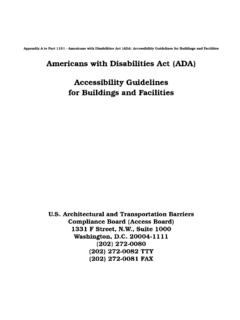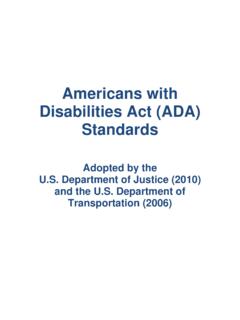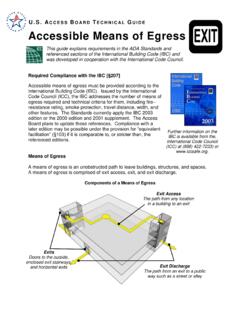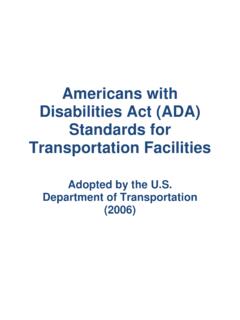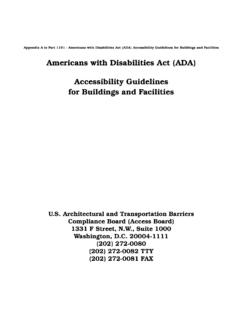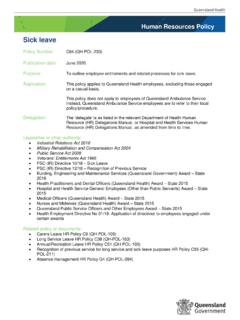Transcription of ADA Scoping: New Construction - United States Access Board
1 ada scoping : New Construction This guide provides an introduction to the scoping requirements that form the basis for the Department of Justice s 2010 ADA Standards and the DOT ADA Standards and is not intended to be comprehensive or used as a stand-alone technical guide to those requirements. Users of this guide must familiarize themselves with the specific scoping requirements that apply to each element, building, facility, or site that is subject to the Standards adopted to implement titles II and III of the ADA. Although this guide focuses on the provisions of Chapter 2 of the ADA Accessibility Guidelines, which form the basis of the DOJ and DOT ADA Standards, the 2010 Standards adopted by DOJ incorporate regulatory language that modifies or augments a number of those provisions, or address certain occupancies that are not specifically addressed in Chapter 2, and these regulatory provisions must be read in conjunction with Chapter 2 to ensure an accurate understanding of the legal requirements.
2 Readers should become familiar with how the 2010 Standards modify the requirements in Chapter 2 and should not assume that by reading the provisions of Chapter 2 alone they will have all the information and perspective they need to achieve compliance with the 2010 Standards. scoping Requirements Requirements in Chapter 2 indicate which elements and spaces must be accessible on a site or in a facility (the scope of coverage). These scoping requirements apply technical provisions in Chapters 3 10 to those covered elements and spaces provided on a site. Applicable building codes, design practices, and other factors determine the elements and spaces required for a site, including parking, means of egress, and plumbing fixtures.
3 The ADA Standards, on the other hand, specify the elements and spaces provided that must be accessible. Application [ 201] The ADA Standards apply to the various types of facilities subject to the ADA, from simple structures to complex, multi-building sites such as university campuses and airports. Requirements in the standards apply to both exterior and interior spaces and elements provided on a site, usually without distinction. Provisions for parking, for example, apply equally to exterior lots and to parking garages. The standards cover permanent facilities and temporary facilities (other than those used in Construction ), such as reviewing stands, stages, portable toilets, and temporary classrooms.
4 In new Construction , all areas must be fully accessible, including multiple spaces of the same type, unless otherwise specified. Areas not required to be fully accessible include: U . S . Access BO A R D TE C H N I C A L GU I D E Chapter 2: ada scoping Requirements New Construction 2 certain limited-use or raised spaces that are exempt ( 203) employee work areas (partial Access ) ( ) spaces covered by scoping provisions that require only a specified portion of the total number to comply, such as dressing rooms and patient bedrooms (various provisions in Chapter 2) Example.
5 Retail Facility This example of a retail facility shows how scoping requirements for certain elements and spaces (sales counters and fitting rooms) apply and indicates employee work areas. SALES FLOOR STOCK ROOM LOADING DOCK Fitting Rooms ( 222) Access is required to at least 5% (but no less than 1) of each type of use in each cluster. Toilet Rooms ( 213) Public use and common use toilet rooms, including employee restrooms, must comply. OFFICE Sales Counters ( 227) Access is required to at least 1 of each type of sales counter provided. If counters are dispersed throughout a facility, accessible counters also must be dispersed.
6 employee Work Areas ( ) Partial Access is required to areas used only by employees for work (worker side of sales counters, offices, stock room, and loading dock). Chapter 2: ada scoping Requirements New Construction 3 Example: Clinical Suite This facility includes public and common use areas and employee work areas. Dressing Rooms ( 222) Access is required to at least 5% (but no less than 1) of each type of use in each cluster. Mechanical Room ( ) Exempt Space employee Work Areas ( ) Partial Access to areas used only by employees for work (reception/ file areas, nurses station, and janitor s closet) Exam Rooms and Offices ( 201 and ) All exam rooms and offices used by the public must be accessible, but elements within these rooms that are used only by employees for work are not required to comply.
7 BREAK ROOM JANITOR S CLOSET WAITING AREA Public Use Spaces ( 201) Full Access to public use areas, including waiting areas and corridors Common Use (Non-Work) Areas ( 201) Full Access to break rooms and to other employee areas not used for work purposes Toilet Rooms ( 213) Access is required to all public and employee toilet rooms (or no more than 50% of single user toilet rooms for each use at each cluster). RECEPTION/ FILES NURSES STATION DOCTOR SOFFICE EXAM ROOM Chapter 2: ada scoping Requirements New Construction 4 General Exceptions [ 203] These structures and spaces are fully exempt from the standards and are not required to be accessible or on an accessible route: Construction Sites ( ) Structures directly associated with the actual processes of Construction and portable toilets used only by Construction workers Examples.
8 Scaffolding, bridging, materials hoists, Construction trailers Areas Raised for Security/ Safety ( ) Areas raised primarily for purposes of security or life/ fire safety Examples: life guard stands, fire towers, and prison guard towers Raised Work Areas ( ) employee work areas under 300 that are elevated at least 7 as an essential functional condition of the space (excluding raised courtroom stations) Example: Work areas with equipment/ machinery that must be operated from a platform Exception Based on Structural Impracticability in DOJ s 2010 ADA Standards and DOT s ADA Regulations DOJ s 2010 ADA Standards and DOT s ADA regulations specify that full compliance is not required in new Construction in rare circumstances where unique characteristics of terrain make the incorporation of accessibility features structurally impracticable.
9 In such a case, the new Construction requirements apply except where the responsible entity can demonstrate that it is structurally impracticable to meet those requirements. This exception is very narrow and should not be used in cases of merely hilly terrain. Even in those circumstances where the exception applies, portions of a facility that can be made accessible must still be made accessible. In addition, Access must be provided for individuals with other types of disabilities, even if it may be structurally impracticable to provide Access to individuals who use wheelchairs.
10 This exception is found in DOJ s 2010 Standards at (a) for title II and (c) for title III and in DOT s ADA regulations at (b). Chapter 2: ada scoping Requirements New Construction 5 Limited Access Spaces ( ) Spaces accessed only by ladders, catwalks, crawl spaces, or very narrow passageways Examples: lighting/ equipment catwalks at stages and performing areas, platforms served only by ladder Machinery Spaces ( ) Spaces used only by service personnel for maintenance, repair, or occasional monitoring of equipment Examples: elevator pits/ penthouses, mechanical/ electrical/ communications equipment rooms, water or sewage treatment pump rooms, electric substations, and transformer vaults Single Occupant Structures ( ) Single occupant structures accessed only by below-grade passageways or elevated above standard curb height Examples.
